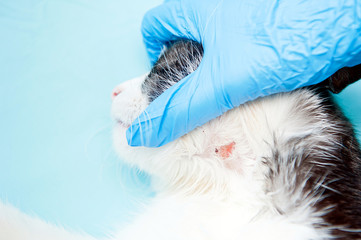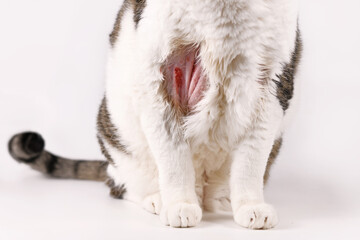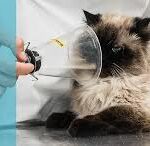Introduction
Skin infection in cats is a common disease. Cats are cherished for their independent nature and unique personalities. However, like all pets, they are susceptible to various health issues, including skin infections. Understanding these infections, their causes, symptoms, and treatments is essential for maintaining your feline friend’s health and well-being.
Table of Contents
What Are Skin Infections in Cats?
Skin infections in cats can occur due to various factors, such as bacteria, fungi, parasites, or allergies. These infections can lead to discomfort, itching, and other severe health issues if not treated promptly. It’s crucial for cat owners to know the signs and seek appropriate treatment.
Types of Skin Infections
- Bacterial Infections
- Fungal Infections
- Parasitic Infections
- Allergic Dermatitis
- Blastomycosis
Some Common Causes of Skin Infections in Cats
Bacterial Infections
Bacterial infections often result from wounds or scratches that become infected. Bacterial skin infections (pyoderma) caused by Staphylococcus pseudointermedius and Pasteurella multicide.
Fungal skin infections, with ringworm being the most common.
Other factors such as allergies, parasites, and injuries can also contribute to skin problems in cats These can be caused by:
- Catfights leading to wounds
- Environmental bacteria
- Poor grooming habits
Fungal Infections
Fungal infections such as ringworm are common in cats. These are highly contagious and can spread to other pets and humans. The primary causes include:
- Contact with infected animals
- Contaminated environments
- Weakened immune system

Parasitic Infections
Parasites like fleas, mites, and ticks can cause severe skin irritation and infections. Common parasitic infections include:
- Flea allergy dermatitis
- Mange (caused by mites)
- Tick infestations
Allergic Dermatitis
Allergies to certain foods, environmental factors, or flea bites can lead to allergic dermatitis, resulting in skin infections. Common allergens include:
- Certain proteins in food
- Pollen, dust, and mold
- Flea saliva
Recognizing Symptoms of Infections in Cats
Studies indicate that between 6 and 15 percent of feline patients have at least one dermatopathy and many cats suffer from more than one. Among cats presented to the dermatology service at the Cornell University Hospital for Animals, for instance, a recent study showed that 22 percent had evidence of two skin diseases and 6 percent have three distinctive skin diseases the symptoms of skin infections in cats is the first step toward treatment. Common symptoms include:
Excessive Scratching and Grooming
Cats with skin infections often scratch or groom excessively, causing further irritation and potential secondary infections.
Redness and Inflammation
Inflamed, red skin is a common sign of infection. This can occur in localized areas or spread over larger body parts.
Hair Loss
Hair loss, especially in patches, can indicate an underlying skin infection. This is often seen in cases of ringworm and flea infestations.
Scabs and Lesions
Scabs, sores, or wounds are severe symptoms that require immediate attention. These can lead to secondary bacterial infections if not treated promptly.

Diagnosing Skin Infections in Cats
Proper diagnosis is essential for effective treatment. Your veterinarian will perform several tests, including:
Physical Examination
A thorough physical examination helps identify visible signs of skin infections and assess the overall health of your cat.
Skin Scrapings and Cultures
Taking samples of skin scrapings or cultures can help identify the specific bacteria, fungi, or parasites causing the infection.
Allergy Testing
If allergic dermatitis is suspected, your vet may recommend allergy testing to identify specific allergens affecting your cat.
Blood Tests
Blood tests can help assess your cat’s overall health and identify any underlying conditions contributing to the skin infection.
Treating Skin Infections
Treatment for skin infections in cats varies depending on the cause. Here’s a step-by-step guide to common treatments:
Bacterial Infections
- Antibiotics: Prescribed to eliminate bacterial infections.
- Topical Ointments: Applied to affected areas to reduce inflammation and promote healing.
Fungal Infections
- Antifungal Medications: Oral or topical antifungal medications are used to treat fungal infections like ringworm.
- Environmental Cleaning: Thorough cleaning of your cat’s environment helps prevent reinfection.
Parasitic Infections
- Flea and Tick Treatments: Regular use of flea and tick preventatives can prevent infestations.
- Medicated Baths: Baths with medicated shampoos can help eliminate parasites and soothe irritated skin.
Allergic Dermatitis
- Identifying and Avoiding Allergens: Removing the allergen from your cat’s environment or diet is crucial.
- Medications: Antihistamines or corticosteroids may be prescribed to manage symptoms.
Preventing Skin Infections in Cats
Prevention is always better than cure. Here are some tips to help prevent skin infections in your cat:
Regular Grooming
Regular grooming helps keep your cat’s skin and coat healthy, removing loose fur, dirt, and parasites.
Balanced Diet
A balanced diet supports a healthy immune system, reducing the risk of infections.
Flea and Tick Control
Regular use of flea and tick preventatives protects your cat from infections.
Clean Environment
When we maintain a clean living environment it reduces the risk of fungal infections and other skin problems.

When to See a Veterinarian
If you notice any symptoms of a skin infection in your cat, it’s essential to seek veterinary care promptly. Early diagnosis and treatment can prevent complications and ensure your cat’s swift recovery.
Signs to Watch For:
- Persistent scratching or grooming
- Visible redness or inflammation
- Hair loss or bald patches
- Scabs, sores, or open wounds
Conclusion
Skin infections in cats can cause serious discomfort and health issues if not treated promptly. By understanding the types, causes, symptoms, and treatments, you can ensure your feline friend remains healthy and happy. Regular checkup, a balanced diet, and prompt veterinary care are key to preventing and managing these infections. Always consult your veterinarian for personalized advice and treatment plans for your cat’s specific needs.





























































